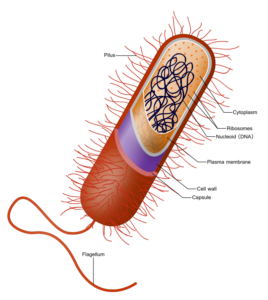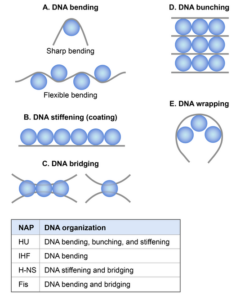Prokaryotes do not have centrioles.
Centrioles are a pair of barrel-shaped cell organelles found in eukaryotic cells- namely in that of animal cells. As prokaryotes are devoid of all cytoplasmic organelles, understandably, they are devoid of centrioles as well.
The question do prokaryotes have centrioles can be makes no sense as they do not need them. Animal cells, which lack cell walls, rely heavily on centrioles. Centrioles are responsible for the formation of microtubules that function as the cell’s skeletal system giving it shape and structure.
Is DNA prokaryotic or eukaryotic?
DNA is neither eukaryotic nor prokaryotic.
DNA or de-deoxyribonucleic acid is the genetic material in most living organisms, both eukaryotic and prokaryotic cells. The DNA structure and shape can differ from organism to organism.
DNA is responsible for containing the genetic material organisms that contain information from one generation to the next. This information includes the structure of the cell, the proteins and biomolecules it needs to synthesize and how to synthesize them. This information is essential to be passed on by an organism from one generation to the next.
The information in DNA regulates how similar a child looks to their parent- their height, blood group, their hair and eye colour, even the diseases that can be genetically passed on. So it needs to be present in all organisms be it eukaryotes or prokaryotes. Even virus has genetic material in the form of DNA or RNA.

Image: Wikipedia
Are prokaryotic cells made of DNA?
Technically speaking prokaryotic cells are not made of DNA.
DNA is a biomolecule nothing more or less. Millions of different biomolecules are required to make a cell. DNA is just one of those million biomolecules that are responsible for containing and transferring genetic information.
A living cell means that prokaryotes and eukaryotes all have a cell wall or membrane enclosing some cell matter or cytoplasm which may have some organelles and genetic material present in them.

Image: Wikipedia
But prokaryotic cells are not as developed. Unlike eukaryotes, they do not possess any membrane-bound organelles. The DNA is circular and just simply floats around in the cytoplasm.
How is DNA different in prokaryotes and eukaryotes?
It is not the DNA, rather the presentation that is different in eukaryotes and prokaryotes.
Eukaryotic DNA is linear and is housed within the nucleus, which is separated from the rest of the cell by a nuclear membrane. Whereas prokaryotic DNA is circular and just simply floats around in the cytoplasm.

Image: Wikipedia
The word prokaryote means that they do not have a true karyon or nucleus. So the genetic material in this case a circular DNA called a nucleoid just floats around in the cytoplasm. Eukaryotes on the other hand have a true nucleus bound by a nuclear membrane to hold its genetic material.
How is DNA stored in a prokaryotic cell?
DNA in prokaryotes are stored in a circular form called a nucleoid.
Normally restricted to the central part of the cell, the circular DNA is called the nucleoid. It is not covered by any membrane and is practically free-floating.
Some prokaryotes also have other DNA fragments out of the nucleoid. These circular DNA fragments are called plasmids. These are characteristically very different from the genetic DNA present in the nucleoid. This plasmid DNA proves to be advantageous in the case of specific environments.
What is unique about the DNA of a prokaryote?
Bacterial DNA is unique in the sense that it has more functions than just being genetic material.
Nucleoid DNA does function in storing of genetic information. But prokaryotes have plasmid DNA as well which has several other functions.
Plasmids are double-stranded circular DNA fragments that exist out of the bacterial nucleoid. The nucleoid contains just a little quantity of DNA, which is in the form of a single molecule, or essentially a single chromosome. Comparing it to humans that have 23 pairs in each cell, the amount of genetic material required for the sustenance of prokaryotes is very minute.
What is the function of DNA in prokaryotic cells?
Unlike eukaryotes, prokaryotic DNA has more functions than just storing genetic material.
In prokaryotes or bacterial the nucleoid DNA contains the genetic material. While the plasmid DNA has other functions.
Plasmid DNA in bacteria is very different from chromosomal DNA. It can be made up of one or more genes. Plasmid DNA is very useful for bacteria in the process of resistance building against anti-biotics. And, through a process known as conjugation, these plasmids may be transmitted from one bacterium to another.
Scientists often use plasmids in labs as tools for cloning, transferring and manipulating the genes they feel are of economic, medical or scientific significance. For example, this very technology was used for the production of pest and drug-resistant crops through recombinant biotechnology.
What does prokaryotic DNA look like?
The circular nature of prokaryotic DNA seen in the nucleoid and plasmids is similar.
Prokaryotic DNA present in the nucleoid consists only of a single, coiled, circular chromosome. This single chromosome contains a single DNA molecule compactly coiled and kept in place by specific proteins.

Image: Wikipedia
Like in eukaryotes prokaryotic DNA also undergoes supercoiling and is kept compact with the help of Nucleoid-associated Proteins (NAPs). But prokaryotes are haploids that is they contain only one strand of chromosome. So they can only reproduce by division, cloning or conjugation.
Do prokaryotes have double-stranded DNA?
Prokaryotes certainly have double-stranded DNA.
The DNA in the nucleoid of bacteria is double-stranded and circular. Double-stranded DNA is more stable and less prone to mutation.
DNA in most organisms except viruses mainly have double-stranded DNA. This implies they can’t mutate as quickly or as easily as viruses.
Do prokaryotes have single-stranded DNA?
Prokaryotes do not possess single-stranded DNA.
Bacteria do not have single-stranded DNA, even if they are premedieval organisms. They have double-stranded circular DNA instead.
Genetic material in the form of single-stranded(ss) DNA in organisms is a very rare occurrence in nature. Due to its unstable structure, it can mutate or malfunction very easily. So ssDNA is only found in certain viruses. But even so, the occurrence is very rare and hard to come by. It is more common to find viruses with ssRNA.
Do prokaryotes have non-coding DNA?
Bacterial cells contain a very minimal 6-14% non-coding DNA.
Non-coding DNA is quite common in eukaryotic DNA, basically 99% of the entire genome. But in the bacterial genome, the fraction is way less. The bacterial genome has only 6-14% of non-coding DNA.
The non-coding section of the genome’s purpose is mostly structural or just unknown. But the bacterial genome is itself a very small molecule, so there isn’t much to stabilize. Where the eukaryotic genome is way more complex and requires regulation so a major portion of it is non-coding in nature.
This does not mean that the non-coding part of DNA is useless, it’s just that scientists have been unable to decipher its mechanism yet.
Also Read:
- Forearm anatomy
- Cytoskeleton and protoplasm
- Heterotrophs examples
- Lactose fermenting bacteria examples
- Protein synthesis structure
- Genetic diversity types
- Does mitochondria have double membrane
- Diffusion in cell
- Non capsulated bacteria
- Are protists monophyletic

I am Trisha Dey, a postgraduate in Bioinformatics. I pursued my graduate degree in Biochemistry. I love reading .I also have a passion for learning new languages.
Let’s connect through linked in: